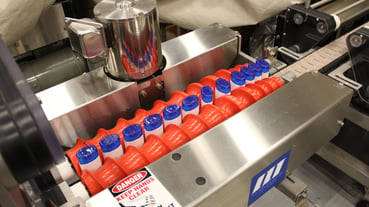Morrison Container Handling Solutions values our customers and their efficiency. Our nearly 50 years of timing screw roots is something we talk about a lot, but it can be confusing to understand the impact they can have on your production line. When at peak performance, timing screws can increase efficiency, your return on investment, and maximize your product output. But here’s how you can decide if a timing screw is right for you and your line.
First, let’s looking at the basics.
What is a timing screw? 
Timing screws, also known as feed screws or worm screws, are helical designed devices that move a product at a specified rate due to the manufactured design of a screw. They are custom to the container being moved and provide positive control, so your output is consistently the same, every time, as one rotation of the screw = one container discharged. Timing screws smoothly move a container for a variety of applications on a packaging line such as metering, check weighing, capping, dwell for filling, labeling, or more.
Timing screws precisely position containers gently on a packaging line at consistent intervals to feed into the next application or better perform the current one.
What does a timing screw do?
Without a timing screw, there is often a lack of positive control, which means the production line can be slowed down by a container that was not positively handled. If a container that was not positively handled is fed into a machine, the container can cause the machine to stop running due to being faulty or being the wrong orientation.
The bottom line? This causes down time.
Morrison’s timing screws (also known as feed screws or worm screws) handle your container with positive control and can dictate where the container goes. Our timing screws handle your container with three points of contact at all times, allowing for optimum control of the container for any application.
Are timing screws right for you?
Timing screws are used to feed, turn, group, twist, invert, combine, and divide containers to their desired
orientation to continue down the production line for applications such as filling, capping, foiling, rinsing, code dating, multi-pack creating, and more. First, ask yourself, are you ready to ensure the exact same thing will happen to your product every single time? If the answer is yes, then you’re ready to allow timing screws to maximize your output and bring in the potential to capitalize on ROI immediately.
Essentially, timing screws can automate costly, laborious processes throughout your plant. Our container handling experts are available to examine your line and see where timing screws can provide solutions for some of the most cumbersome tasks.
Learn more in the webinar video on how screws eliminate workforce needs. 👉🏼👉🏼👉🏼
Should I add a timing screw to my line?
Do you have rigid or semi-rigid containers that need better handling? Adding a timing screw to your production line decreases the number of operators needed due to resolving feed errors and jams. What does this ultimately mean for your packing line? Timing screws increase uptime and allow you to run your production line at a higher rate.
In certain applications, screws can also work with flexible packaging. Don't discount the use until you've spoke with one of our experts! They're the go-to when deciding what technology can improve your lines.
We believe that building a team of reliable experts lies in our unparalleled dedication to your efficiency and support.
Morrison wants to increase your line efficiency and consistency. Our customers come first here at Morrison, with our dedication to Support Built In®, and we are here to guide you along every step of the way.
Give us a call at 708-756-6660 or contact your sales representative to decide if timing screws can have the impact on your line that you need.


